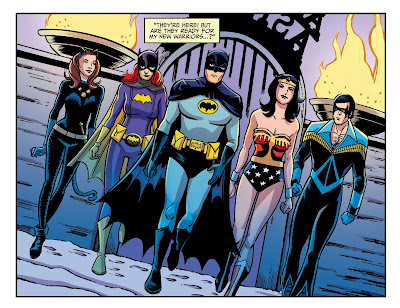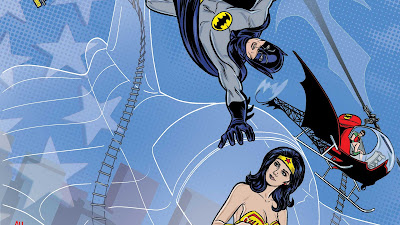An on-screen teaming of Adam West's Batman, Burt Ward's Robin and Lynda Carter's Wonder Woman wouldn't have been so far-fetched a few decades back. A couple of Justice League/DC video-taped team-ups featuring West and Ward had become a reality in the '70s (remember Hanna-Barbera's "Legend of the Superheroes"?); and "Wonder Woman", like West/Ward's classic series, was known to invite big-name stars to the show and sprinkle it with good-spirited camp. Of course, if the crossover had occurred, it would have likely taken place in "Wonder Woman'"s third (Disco Era) season, though a crafty flashback could have connected the earlier periods.
For what it's worth, such a crossover has reached fruition, and it even features an intriguing, time-linking prelude. "Batman '66 Meets Wonder Woman '77" is a 6-issue collection now available in one, easy-to-grab, affordable (hardback) volume, but to the chagrin of some, the content may prove as peculiar as it's fulfilling.
In this instance, writers Marc "Bruce Wayne: the Road Home" Andreyko and Jeff "Batman '66 Meets the Man from U.N.C.L.E." Parker give us the more recent Dark Knight adversary, Ra's al Ghul, who rejuvenates himself within the legendary Lazarus Pit to resume his post as League of Shadows guru. Along the way, he faces Bruce Wayne, whom he first met during the crime fighter's youth: circa WWII, when Diana Prince/Wonder Woman just happened to be on hand to rescue the youngster. (BTW: the latter initiates a surprising, new genesis for the Caped Crusader.)
Yes, an interesting concept, which does click for the most part, except the look and texture feels post '90s even when we're in the '40s, '60s and '70s, with characters sometimes appearing in tune with their original stations, yet at other times stepping from out molds that are far too extrapolated.
For example, though Ward's Boy Wonder consumes most of the plot, he's replaced (er, that is, becomes) Nightwing in the story's final phase. Whether Ward is, in fact, supposed to be playing the "matured" crime fighter is anybody's guess, since the depicted costume and height variance thwarts a precise impression. One's imagination is left to decide the matter, though for most of us, the idea of recasting would seem illogical, if not undignified. Clarity (via physical emulation or prevailing verbiage) would have helped.
Also, though West's Bruce Wayne/Batman is represented by an apt likeness, Carter's Diana Prince/Wonder Woman does seem to fluctuate throughout the adventure (as she does in DC/Dynamite's "Wonder Woman '77 Meets the Bionic Woman": soon to be reviewed). At the same time, there's no mistaking the actress' enchanting glow, even when her physicality is blurred. In fact, the mighty Amazon's placement among the panels becomes the team-up's predominate highlight.
On the whole, therefore, the artwork of David Hahn (as assisted by Karl Kesel; Bill Williams; Wes Abbot; Alex Ross; and "Madpencil") wavers in its execution, though when it counts, never fails to give the exploits a movie-serial vivacity, no matter what the decade. Fans will also appreciate the parade of supplemental characters who visit the panels: some in significant supporting roles and others relegated to cameos.
On the side of virtue, we find Batgirl (an implied, older Yvonne Craig) and Catwoman (okay, her virtue is debatable): at first represented by a villainous Eartha Kitt, who's then replaced by a Julie Newmar/Lee Meredith variant, acting at one point as the Dynamic Duo's for-appearance-only escort to Paradise Island. There's also a sprightly visit from Deborah Winger's Wonder Girl.
Alas, as a missed-opportunity, Lyle Waggoner's Steve Trevor comes and goes, with any resemblance to the actor being at best minor. A definitive take would have made the performer's inclusion more ironic, since Waggoner was, after all, West's main competitor to portray Batman.
On the henchmen side, we're offered Ra's Al Ghul's daughter, Talia (both in adult and child form); Cesar Romero's Joker; Frank Gorshin's Riddler; and nondescript (though highly detailed) versions of Mr. Freeze; Killer Croc; Clayface; Copperhead; and Cheetah: a grand group for sure, though again, the modern manifestations often distract from the nostalgic feel. In other words, their appearances within their particular landscapes are welcome, but still present an uncanny-valley awkwardness.
In a similar fashion, the story's sprawling backdrops and intricate interludes seize one's attention with their mythological monsters, assailing warriors and CinemaScope maze, but are otherwise a bit much, contradicting what the original shows could have afforded during their runs. (On second thought, such ingredients could have been featured way-back-when, but would have been nowhere near as lustrous as they're drawn and pigmented within this parallel track.)
Again, such see-sawing forces "Batman Meets Wonder Woman" to stand as something other than its intent, which becomes further punctuated by its slick '70s segment. On the other hand, compared to most current, published superhero sojourns (whether DC or Marvel), the adventure avoids becoming condescending or politically highbrow. In that respect, even if the conceptualization seems more a thing of its own, in heart and soul, it does capture the originals' moral sensibilities: an honorable asset.
On the whole, there's enough good (even well-crafted cleverness) in "Batman Meets Wonder Woman" to pave the way for more DC/Dynamite decades-hopping experimentation. The ending sure implies a Justice League emergence; so why not tinker with the various crossover potentials? It's always nice, too, to see our old favorites interacting again, if not on the television screen, then at least on the printed page, where (no matter the outcome) an imaginative seed can always take root.









No comments:
Post a Comment